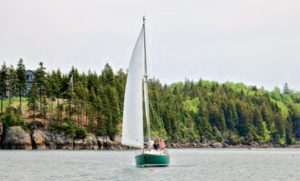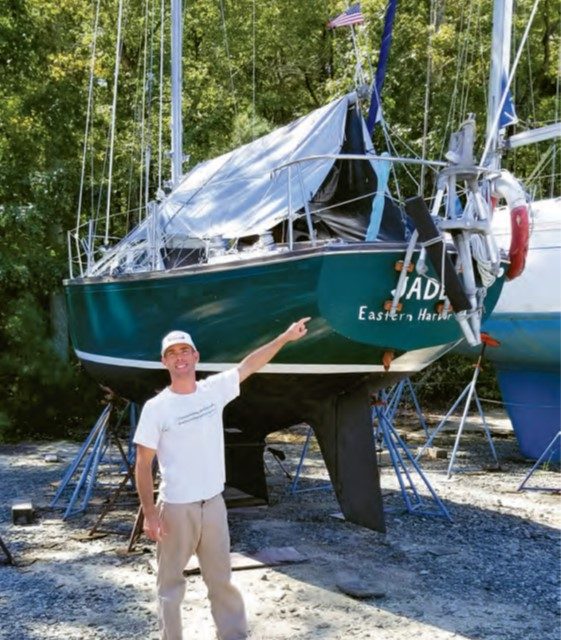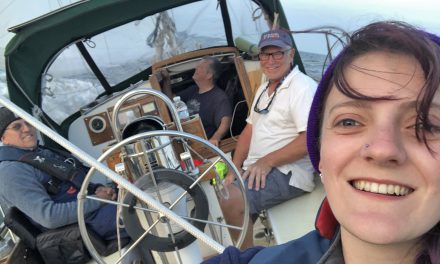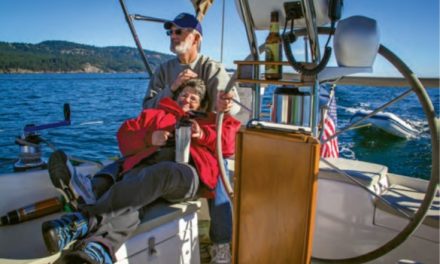Deciding to sell the boat was tough enough. Then came the “buyers.”
Issue 136: Jan/Feb 2021
I was done. I was dangling from the top of my mast, trying to free the tangled jib halyard as boat wakes on Florida’s ICW rocked me back and forth. I was exhausted. My new autopilot had malfunctioned in the Bahamas, and I’d just endured a 36-hour hand-steering run across the Gulf Stream. Now the roller furler was shot. From high up, I stared down at my boat, a Tartan 34c named Jade, then out at the blue spread of ocean beyond the line of condos.

Jade underway with newly refurbished sails.
I loved the sailing and the water and the culture, but I was flat-out sick of working on my boat. It’s said that you have to enjoy working on the boat as much as you do sailing it, because it’s a 50-50 proposition. That equation proved true for me, and I didn’t have the fix-it bug most sailors seem to have.
I listed Jade for sale the next day before motoring north up the ICW. I was flooded with mixed feelings. I was selling some part of myself.
By the time I reached New Smyrna Beach, a guy from California had responded to my ad. He wanted her at $1,000 over my asking price. I was confused; he hadn’t asked me a single question. How could he make an offer like that? And did it mean anything more than that he was interested? Would he come see her, then either back out or change his offer?
Several friends were anchored in New Smyrna, and it didn’t take long for their energy to infect me; how could I sell such a great boat? One of them had an Aries wind vane he’d help install. Another would help with the furler replacement. Friends I’d met in the Bahamas offered dock space in South Carolina where we could all congregate to work on Jade.
The frustration and exhaustion faded as we drank beers and talked sailing. The group consensus was that the California offer was bogus at best, and certainly not worth changing my schedule. I turned the guy down, took Jade off the market, and headed for South Carolina.
The work there went well, and I was thankful for all the help from friends, but by the time I reached the Chesapeake Bay, I’d begun regretting not pursuing the offer. I’d come to understand that to be a true solo sailor, sailing—and therefore your boat—must be the top priority, the be-all and end-all. I missed wild rivers and big mountains. And, perhaps more impor¬tantly, if I were going to sail, I wanted a partner aboard, and the harbors and anchorages where I’d stopped along the Eastern Seaboard were not good spots to meet a woman, especially if one hoped for her to be single and under 60 years old.
I hauled Jade out in the Chesapeake, figuring I’d go home and work, then decide if I wanted to sell or sail.
Months later, I put Jade back up for sale, and once again, I received several offers right away. One from the Caribbean, one from Texas. After some back and forth, the guy in the Caribbean asked if I’d deliver her and take him along for the ride as I did so. I declined.
The Texas guy bought a plane ticket to Virginia, and I agreed to meet him there. If the boat was as advertised, he’d pay me on the spot. He was familiar with the Tartan 34c and had been looking for a long time.
From my cabin in Down East Maine, it was a 16-hour drive to the boatyard. I loaded all the sails and gear into my car, tied the Aries to the roof, and hit the road. After arriving in Virginia, I spent the next day cleaning and prepping the boat.

With the teak finally oiled, Jon updates the logbook on a flat-calm day.
Again, I had mixed feelings; going through a boat is like flipping through a photo album or a box of old letters. Memories flooded in, special anchorages, cruisers I’d met, some I’d see again, others I would not. At night, the orange glow on the teak made me pine for life aboard, as did the sound of sliding the burner open on the Origo stove, and the faint smell of the Westerbeke, and the creak of the ladder, and the feel of the tiller in my hand.
But I was also reminded of the work I’d done refitting Jade, and those were not good memories. I was never able to find peace in boat work, or even satisfaction or pride; it was always something I pushed through in order to reach the other side, and that is no way to spend so much time.
The buyer showed up the next day. He was a doctor and a lawyer both—he claimed—and he looked the boat over, tapping on the hull with a little physician’s hammer as if sounding for moisture or rot. But given the random places he tapped, I realized that he had no idea what he was doing. He took pictures and used an app on his phone to judge the plumb of the mast. I pointed out that the boat wasn’t level on her stands, but that didn’t seem to faze him.
When his inspection was finished, we sat in the cockpit and drank a few beers, then went for dinner. He was staying in a nearby hotel, and after dinner, he said that he’d be at the boatyard first thing in the morning to pay me and transfer the boatyard paperwork to his name.
I agreed.
And I never saw him again. I waited around the yard for hours. He didn’t call or email. Maybe he was a late sleeper, but by 11, I decided to pack up and hit the road. I had to prep Jade for storage, then drive 16 hours.
A few days later, I received an email from him. He said that he had decided to decline Jade for one simple reason. He’d noticed that the engine and prop shaft weren’t in line with the hull, and that would cause the boat to motor in circles, and he couldn’t have a boat that just spun in circles, so he was therefore rescinding his offer.
I was flabbergasted by both his behavior and his logic. The 34c is a famous Olin Stephens design. It’s no slouch. Stephens’ engine placement was designed for maximum efficiency and balance. I explained this to the buyer, but he disagreed with me, and said that my 34c was more offset than others, and would, therefore, motor in circles.
I’d sailed Jade thousands of miles, and while I hadn’t gone in a straight line, the only circles I’d gone in had been emotional.
I deleted his contact information and emails in order to restrain myself from lashing out at him. I chastised myself for spending so much time and energy on him. I’d even given him two of my beers.

Jon stands next to Jade in a boatyard in Reedville, Virginia, where he put her up for sale for the last time.
By then, some things he’d said began to make sense. He’d told me he’d flown to Vermont to look at a beautiful 34c on Lake Champlain. He’d almost bought her, but he’d realized that the mast would have to be unstepped in order to transport her, so the deal was off. Then another story in a similar vein, a boat that was perfect save for one inane point that was clearly—to him—a deal breaker.
It had never occurred to me that a guy with money to burn might make a habit of flying around and almost buying boats. Was he addicted to the rush of yanking someone’s chain? Was he too scared to commit to a boat, so he’d find some reason not to go through with it? Was he just flat bored and wanted an excuse to travel?
I talked to a broker, but a brokerage didn’t make sense for an old boat that would be listed for under 20K, especially after the broker’s first comment was, “You could donate it for a tax write-off.” Tax write-off? I don’t know what tax bracket she thought I was in, but there was clearly a disconnect.
I took Jade off the market until the following spring. When I re-listed her, I braced myself, ready for shenanigans. I received some strange emails. A guy explained his love of skiing. A woman who, upon my having responded to her questions, said that there was clearly a reason the two of us were corresponding with one another—we had a connection, she said— and perhaps we should share the boat?
I sent lots of pictures to several people who were very serious, and even allowed a handful to go look her over at the boatyard on their own. A theme emerged. Men used their wives as excuses for not buying Jade.
“She’s perfect for me—I want a no-frills sailboat—but my wife wants more comforts.”
“Like what?” I’d ask. And they would list every item that my ad made clear Jade did not have, such as AC and pressurized hot water.
Finally, I arrived at the point where I’d be just as happy keeping Jade as I would be selling her. Then, a young guy contacted me. I told him everything that was wrong with Jade. I gave him the key so he could go check her out. I sent him an article about all the work I’d done on her. I told him no one else was looking at her, so he could take his time. Essentially, I did everything a seller shouldn’t do, and that was my intention, to be the kind of seller from whom I’d want to buy a boat.
And, he bought her.
I haven’t heard from Jade’s new owner since he launched her, and at times I miss her—like now, as I write this, I miss the sailing and the anchorages and the other sailors. But I remind myself that there are always more boats out there, and the next time I buy a boat, I’m buying one that some other poor bastard has already refitted.
Jon Keller is a writer, clam digger, and carpenter. He divides his time between Maine and Montana. He’s currently finishing his second novel and looking for his second old boat.
Thank you to Sailrite Enterprises, Inc., for providing free access to back issues of Good Old Boat through intellectual property rights. Sailrite.com





